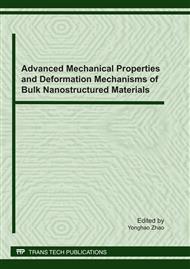[1]
H.J. Frost and M.F. Ashby: Deformation-Mechanism Maps, Pergamon Press, Oxford (1982).
Google Scholar
[2]
W. Blum: High-Temperature Deformation and Creep of Crystalline Solids, in Plastic Deformation and Fracture of Materials, edited by H. Mughrabi, Vol. 6 of Materials Science and Technology, edited by R.W. Cahn, P. Haasen and E.J. Kramer, VCH Verlagsgesellschaft, Weinheim (1993).
DOI: 10.1002/cite.330651022
Google Scholar
[3]
W. Blum, A. Absenger and R. Feilhauer: Dislocation Structure in Polycrystalline AlZn during Transient and Steady State Creep in Proc. 5th Int. Conf. on the Strength of Metals and Alloys (ICSMA 5), edited by P. Haasen, V. Gerold and G. Kostorz, Pergamon Press, Oxford (1980).
DOI: 10.1016/b978-1-4832-8412-5.50051-5
Google Scholar
[4]
S. Mekala, P. Eisenlohr and W. Blum: Philos. Mag. A, in print.
Google Scholar
[5]
H. Abral, J. Kroc, W. Blum and J. Hirsch: Microstructure and Deformation Resistance in Rolling of Aluminium Foil, in Aluminum Alloys Their Physical and Mechanical Properties, Proc. ICAA-6, edited by T. Sato, S. Kumai, T. Kobayashi and Y. Murakami, Vol. 1, The Japan Institute of Light Metals, Tokyo (1998).
Google Scholar
[6]
H.J. McQueen, E. Evangelista, M. Cabibbo, and G. Avramovic-Cingara: Canadian Metallurgical Quarterly 47 (2007), p.71.
DOI: 10.1179/cmq.2008.47.1.71
Google Scholar
[7]
D.A. Hughes: The evolution of deformation microstructures and local orientations, in Proc. of the 16th Risø Int. Symp.: Microstructural and Crystallographic Aspects of Recrystallization , edited by N. Hansen, D. Juul Jensen, Y.L. Liu and B. Ralph, Risø National Laboratory, Roskilde, Denmark (1995).
Google Scholar
[8]
D.A. Hughes and N. Hansen: Acta Mater. 45 (1997), p.3871.
Google Scholar
[9]
D.A. Hughes, N. Hansen, and D.J. Bammann: Scripta Mater. 48 (2003), p.147.
Google Scholar
[10]
M. Cabibbo, W. Blum, E. Evangelista, M.E. Kassner and M.A. Meyers: Metall. Mater. Trans. 39A (2008), p.181.
Google Scholar
[11]
W. Blum and H.J. McQueen: Materials Science Forum Vol. 217-222 (1996), p.31.
Google Scholar
[12]
Y.J. Li and W. Blum: phys. stat. sol. (a) 202 (2005), p. R119.
Google Scholar
[13]
Y.J. Li, X.H. Zeng and W. Blum: Mater. Sci. Eng. A 483-484 (2008), p.547.
Google Scholar
[14]
W. Blum, Y.J. Li and K. Durst: Acta Mater. 57 (2009), p.5207.
Google Scholar
[15]
W. Blum, Y.J. Li, J.T. Wang and Y. Zhang: to be submitted to Mater. Sci. Eng. A.
Google Scholar
[16]
E. Nes: Modelling work hardening and stress saturation in FCC metals, Progr. Mater. Sci. 41 (1998), p.129.
Google Scholar
[17]
S.F. Exell and D.H. Warrington: Philos. Mag. 26A (1972) 1121.
Google Scholar
[18]
S. Vogler and W. Blum: Micromechanical modelling of creep in terms of the composite model, in Creep and Fracture of Engineering Materials and Structures, edited by B. Wilshire and R.W. Evans, The Institute of Metals, London (1990), p.65.
Google Scholar
[19]
M. Biberger and W. Blum: Philos. Mag. 66A (1992), p.27.
Google Scholar
[20]
T. Gorkaya, D.A. Molodov and G. Gottstein: Acta Mater. 57 (2009), p.5396.
Google Scholar
[21]
J.S. Dubey, H. Chilukuru, J.K. Chakravartty and W. Blum: Mater. Sci. Eng. A 406 (2005), p.152.
Google Scholar
[22]
B. Holmedal, K. Marthinsen and E. Nes: Z. Metallkd. 96 (2005), p.532.
Google Scholar
[23]
P. Eisenlohr, M. Winning, and W. Blum: phys. stat. sol. (a) 200 (2003), p.339.
Google Scholar
[24]
D.A. Molodov, V.A. Ivanov and G. Gottstein: Acta Mater. 55 (2007), p.1843.
Google Scholar
[25]
T. Gorkaya, T. Burlet, D.A. Molodov and G. Gottstein: Scripta Mater. 63 (2010), p.633.
Google Scholar
[26]
W. Müller, M. Biberger and W. Blum: Philos. Mag. 66A, (1992), p.717.
Google Scholar
[27]
M. Meier, Q. Zhu and W. Blum: Z. Metallkde. 84 (1993), p.263.
Google Scholar
[28]
Y.J. Li, X.H. Zeng and W. Blum: Acta Mater. 52 (2004), p.5009.
Google Scholar
[29]
X.H. Zeng, P. Eisenlohr and W. Blum: Mater. Sci. Eng. A 483-484 (2008), p.95.
Google Scholar
[30]
W. Blum and X.H. Zeng: Acta Mater. 57 (2009), p. (1966).
Google Scholar
[31]
T. Niendorf, J. Dadda, D. Canadinc, H.J. Maier, and I. Karaman: Mater. Sci. Eng. A 517 (2009), p.225.
Google Scholar
[32]
R. Kapoor, Y.J. Li, J.T. Wang, and W. Blum: Scripta mater. 54 (2006), p.1803.
Google Scholar
[33]
W. Blum, P. Eisenlohr and V. Sklenicka: in Bulk Nanostructured Materials, edited by M. Zehetbauer and Y.T. Zhu, Wiley-VCH, Weinheim (2009), p.519.
Google Scholar
[34]
F. Breutinger. Verformungsverhalten und Verformungskinetik von Titan technischer Reinheit und der Titanlegierung TiAl6V4 im Bereich niedriger homologer Temperaturen von 0, 22 (150 ◦C) bis 0, 48 (650 ◦C ). PhD thesis, University of Erlangen-Nürnberg (2006).
Google Scholar
[35]
F. Mompiou, D. Caillard and M. Legros: Acta Mater. 57 (2009), p.2198.
Google Scholar
[36]
D. Caillard, F. Mompiou and M. Legros: Acta Mater. 57 (2009), p.2390.
Google Scholar
[37]
X. Molodova, G. Gottstein, M. Winning, and R.J. Hellmig: Mater. Sci. Eng. A 460–461 (2007), p.204.
Google Scholar
[38]
Y.J. Li, R. Kapoor, J.T. Wang and W. Blum: Scripta Mater. 58 (2008), p.53.
Google Scholar
[39]
N. Kamikawa, X.X. Huang, and N. Hansen: J. Mater. Sci. 43 (2008), p.7313.
Google Scholar


